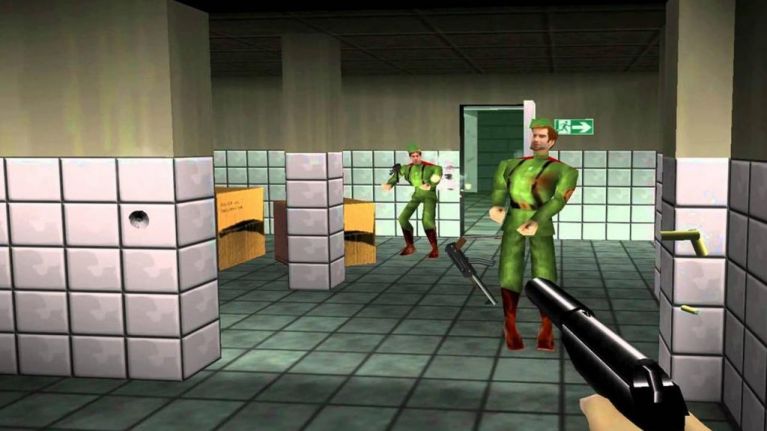[polldaddy poll=10475263]
Your preference in this matchup may come down to something as simple as console capabilities. When Baseball Stars came out on the NES, 2D graphics were the only game in town. There was no way of making games look photorealistic and so Baseball Stars didn’t try. They just tried to make the best overall baseball game they could—franchise features and all. The Nintendo 64, on the other hand, was part of the first generation of consoles capable of handling 3D graphics, and so began the non-stop rat race of always trying to improve our 3D graphics to create better-looking player models, more realistic physics engines, and smoother-looking gameplay. While this process has been a long one, it has allowed for so much more nuance in gameplay, which begs the question: Does the on-the-field gameplay of Ken Griffey Jr.s Slugfest beat out the robust features of Baseball Stars?
Gameplay: Diving right into that statement, there’s no question that Slugfest provides better gameplay from a pure on-the-field perspective. Don’t get me wrong, the timing-based gameplay of Baseball Stars is fun in its own right, but everything is just so much more developed in Slugfest. Pitches are more than just if you want to throw the ball fast or slow, now you can add curve to that and move the aim of your pitch right before it’s released. Batting is more than just timing the pitch, you also have to aim your swing as well. I know I’m simplifying the differences between the two, but that’s really what it comes down to.
Replayability: Interestingly, this matchup rings eerily similar to the first round that Baseball Stars found itself in. This is the area that Baseball Stars shines, and even doubly so when contrasted to its rival in this round of the tournament. Slugfest, like Bases Loaded 4 before it, has a very basic season mode, with the ability to take over a current team (the fantasy draft is horribly broken) and try to improve the roster and win the title. However, trading players, signing free agents, and even changing your lineup are all tedious tasks as you have to open each player’s individual player card to see their ratings. It takes forever to go in and out, and you better not forget any of the ratings you read, cause you won’t want to have to go back and open that player card again. I couldn’t find any way to develop players and it really is just an organized way to play pickup games that end up with stats and standings. Not much else to it.
Baseball Stars made sure to make their season mode the best one out there, and I think that’s the major reason why this game is still beloved today. Not only could you develop your player in their key baseball attributes, but there was a Prestige system that played into both the amount of money you could make selling tickets, as well as the price you’d pay in salary for each player. I cannot do this section any more justice than Justin Paradis did in the first round, so I’m just going to include his recap of this system here.
Perhaps the most interesting thing was Prestige. A team full of players with prestige allowed the game player to earn more money at the gate. This money could then be used to train other players on their team. The manner in which the training was allocated was completely up to the game player until a maximum of 90 points was attained. Alternatively, a player with a low ceiling could be fired in lieu of a rookie with a higher ceiling. Players’ salaries were always commensurate with their abilities (remember baseball analytics had yet to suppress player market values, or was that the owners? I forget). Salaries ended up ranging between $1,000 for a bad player to over $2 million for a bonafide star. That made it compelling to develop your own talent.
Graphics: I touched on this in the opening paragraph, that how you decide on this category will really come down to preference. I think Baseball Stars was a bit better for its time period than Slugfest was, but the early days of the N64 saw many games with weird-looking humans due to the limited capability of the polygon models. It’s hard to fault Slugfest when GoldenEye 007 came out in the same time period and looked like this:

Ultimately, I think Baseball Stars should get the edge as the non-baseball stuff (menus, player cards, etc) were better than in Slugfest, but it’s pretty close.
Sound: Both games are fine in this aspect. Baseball Stars has better music, Ken Griffey Jr.s Slugfest has better in-game sounds. I can’t fault you for liking either one of these more than the other.
Conclusion: While each game has its merits, I think Baseball Stars did more with less, proving that you don’t need a better console or 3D graphics to make a better baseball video game. The best part of either game was clearly the season mode in Baseball Stars, and there isn’t a single aspect of Ken Griffey Jr.s Slugfest that comes close to reaching the heights that that mode does. Given that, I personally would give the nod to Baseball Stars.
Check out the full review for Baseball Stars here
Check out the full review for Ken Griffey Jr.s Slugfest here
Featured Image by Justin Paradis (@freshmeatcomm on Twitter)
